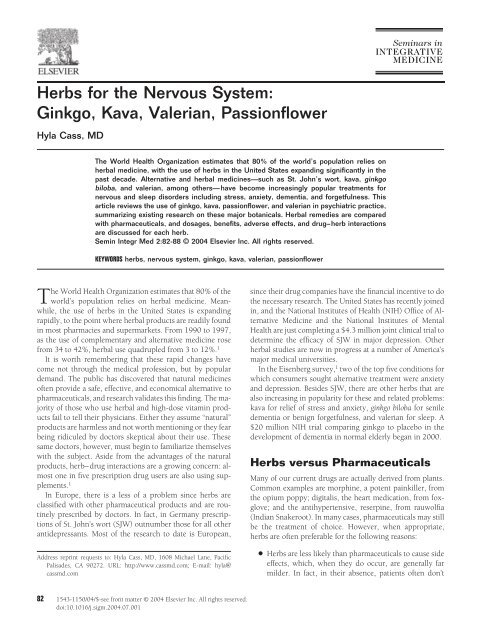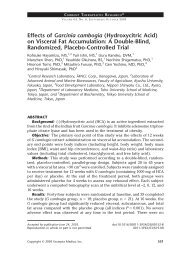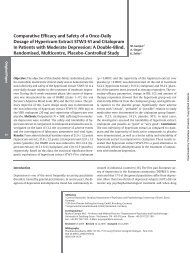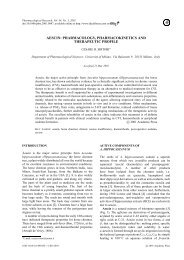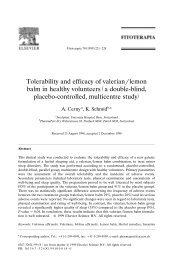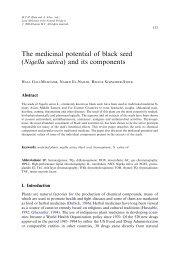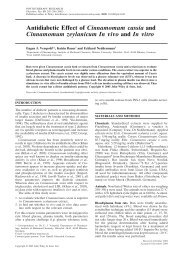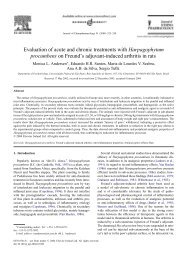Herbs for the Nervous System: Ginkgo, Kava, Valerian ... - Nutraxin
Herbs for the Nervous System: Ginkgo, Kava, Valerian ... - Nutraxin
Herbs for the Nervous System: Ginkgo, Kava, Valerian ... - Nutraxin
You also want an ePaper? Increase the reach of your titles
YUMPU automatically turns print PDFs into web optimized ePapers that Google loves.
<strong>Herbs</strong> <strong>for</strong> <strong>the</strong> <strong>Nervous</strong> <strong>System</strong>:<br />
<strong>Ginkgo</strong>, <strong>Kava</strong>, <strong>Valerian</strong>, Passionflower<br />
Hyla Cass, MD<br />
The World Health Organization estimates that 80% of <strong>the</strong> world’s population relies on<br />
herbal medicine, with <strong>the</strong> use of herbs in <strong>the</strong> United States expanding significantly in <strong>the</strong><br />
past decade. Alternative and herbal medicines—such as St. John’s wort, kava, ginkgo<br />
biloba, and valerian, among o<strong>the</strong>rs—have become increasingly popular treatments <strong>for</strong><br />
nervous and sleep disorders including stress, anxiety, dementia, and <strong>for</strong>getfulness. This<br />
article reviews <strong>the</strong> use of ginkgo, kava, passionflower, and valerian in psychiatric practice,<br />
summarizing existing research on <strong>the</strong>se major botanicals. Herbal remedies are compared<br />
with pharmaceuticals, and dosages, benefits, adverse effects, and drug–herb interactions<br />
are discussed <strong>for</strong> each herb.<br />
Semin Integr Med 2:82-88 © 2004 Elsevier Inc. All rights reserved.<br />
KEYWORDS herbs, nervous system, ginkgo, kava, valerian, passionflower<br />
The World Health Organization estimates that 80% of <strong>the</strong><br />
world’s population relies on herbal medicine. Meanwhile,<br />
<strong>the</strong> use of herbs in <strong>the</strong> United States is expanding<br />
rapidly, to <strong>the</strong> point where herbal products are readily found<br />
in most pharmacies and supermarkets. From 1990 to 1997,<br />
as <strong>the</strong> use of complementary and alternative medicine rose<br />
from 34 to 42%, herbal use quadrupled from 3 to 12%. 1<br />
It is worth remembering that <strong>the</strong>se rapid changes have<br />
come not through <strong>the</strong> medical profession, but by popular<br />
demand. The public has discovered that natural medicines<br />
often provide a safe, effective, and economical alternative to<br />
pharmaceuticals, and research validates this finding. The majority<br />
of those who use herbal and high-dose vitamin products<br />
fail to tell <strong>the</strong>ir physicians. Ei<strong>the</strong>r <strong>the</strong>y assume “natural”<br />
products are harmless and not worth mentioning or <strong>the</strong>y fear<br />
being ridiculed by doctors skeptical about <strong>the</strong>ir use. These<br />
same doctors, however, must begin to familiarize <strong>the</strong>mselves<br />
with <strong>the</strong> subject. Aside from <strong>the</strong> advantages of <strong>the</strong> natural<br />
products, herb–drug interactions are a growing concern: almost<br />
one in five prescription drug users are also using supplements.<br />
1<br />
In Europe, <strong>the</strong>re is a less of a problem since herbs are<br />
classified with o<strong>the</strong>r pharmaceutical products and are routinely<br />
prescribed by doctors. In fact, in Germany prescriptions<br />
of St. John’s wort (SJW) outnumber those <strong>for</strong> all o<strong>the</strong>r<br />
antidepressants. Most of <strong>the</strong> research to date is European,<br />
Address reprint requests to: Hyla Cass, MD, 1608 Michael Lane, Pacific<br />
Palisades, CA 90272. URL: http://www.cassmd.com; E-mail: hyla@<br />
cassmd.com<br />
82 1543-1150/04/$-see front matter © 2004 Elsevier Inc. All rights reserved.<br />
doi:10.1016/j.sigm.2004.07.001<br />
since <strong>the</strong>ir drug companies have <strong>the</strong> financial incentive to do<br />
<strong>the</strong> necessary research. The United States has recently joined<br />
in, and <strong>the</strong> National Institutes of Health (NIH) Office of Alternative<br />
Medicine and <strong>the</strong> National Institutes of Mental<br />
Health are just completing a $4.3 million joint clinical trial to<br />
determine <strong>the</strong> efficacy of SJW in major depression. O<strong>the</strong>r<br />
herbal studies are now in progress at a number of America’s<br />
major medical universities.<br />
In <strong>the</strong> Eisenberg survey, 1 two of <strong>the</strong> top five conditions <strong>for</strong><br />
which consumers sought alternative treatment were anxiety<br />
and depression. Besides SJW, <strong>the</strong>re are o<strong>the</strong>r herbs that are<br />
also increasing in popularity <strong>for</strong> <strong>the</strong>se and related problems:<br />
kava <strong>for</strong> relief of stress and anxiety, ginkgo biloba <strong>for</strong> senile<br />
dementia or benign <strong>for</strong>getfulness, and valerian <strong>for</strong> sleep. A<br />
$20 million NIH trial comparing ginkgo to placebo in <strong>the</strong><br />
development of dementia in normal elderly began in 2000.<br />
<strong>Herbs</strong> versus Pharmaceuticals<br />
Many of our current drugs are actually derived from plants.<br />
Common examples are morphine, a potent painkiller, from<br />
<strong>the</strong> opium poppy; digitalis, <strong>the</strong> heart medication, from foxglove;<br />
and <strong>the</strong> antihypertensive, reserpine, from rauwolfia<br />
(Indian Snakeroot). In many cases, pharmaceuticals may still<br />
be <strong>the</strong> treatment of choice. However, when appropriate,<br />
herbs are often preferable <strong>for</strong> <strong>the</strong> following reasons:<br />
● <strong>Herbs</strong> are less likely than pharmaceuticals to cause side<br />
effects, which, when <strong>the</strong>y do occur, are generally far<br />
milder. In fact, in <strong>the</strong>ir absence, patients often don’t
Herbal medicine 83<br />
notice <strong>the</strong> subtle improvements that occur as <strong>the</strong>se natural<br />
medicines begin to take effect. This contrasting lack<br />
of side of effects may also confound double-blind studies<br />
comparing <strong>the</strong> two. A partial explanation <strong>for</strong> <strong>the</strong><br />
milder side effects may be that <strong>the</strong> original plant constituents<br />
are more compatible with our chemistry.<br />
● Although <strong>the</strong> isolated active ingredient has been assumed<br />
to be most efficient, <strong>the</strong>re are advantages to using<br />
<strong>the</strong> whole plant. While Western medicine seeks to isolate<br />
a single active ingredient, herbal medicine relies on<br />
<strong>the</strong> synergistic action of a plant’s many constituents.<br />
● These combinations may also yield a variety of effects.<br />
For example, by its action on <strong>the</strong> brain, kava acts as an<br />
anxiety reliever, while its relaxant effects are due to its<br />
direct action on both smooth and striated muscle.<br />
● <strong>Herbs</strong> are working physiologically to restore balance<br />
ra<strong>the</strong>r than simply targeting a symptom. As a result,<br />
herbs often tend to take effect more gradually than<br />
pharmaceuticals.<br />
Safety<br />
Side effects of psychiatric drugs can be serious, <strong>the</strong> worst<br />
being death by overdose. According to one report, overdoses<br />
yielded an annual rate of 30.1 deaths per 1 million prescriptions<br />
of antidepressant. On <strong>the</strong> o<strong>the</strong>r hand, to quote Norman<br />
Farnsworth, PhD, Professor of Pharmacognosy at <strong>the</strong> University<br />
of Illinois, Chicago: “Based on published reports, side<br />
effects or toxic reactions associated with herbal medicines in<br />
any <strong>for</strong>m are rare . . . In fact, of all classes of substances . . . to<br />
cause toxicities of sufficient magnitude to be reported in <strong>the</strong><br />
United States, plants are <strong>the</strong> least problematic.” 2 It is important<br />
to caution patients that if <strong>the</strong>y feel any ill effects from an<br />
herbal product, <strong>the</strong>y should in<strong>for</strong>m <strong>the</strong> prescribing doctor.<br />
Depending on <strong>the</strong> severity, <strong>the</strong> patient <strong>the</strong>n should ei<strong>the</strong>r<br />
reduce <strong>the</strong> dose or stop taking <strong>the</strong> herb altoge<strong>the</strong>r. Unlike<br />
pharmaceuticals, withdrawal reactions are rarely an issue.<br />
Herb–Drug Combinations<br />
It is essential to obtain a complete drug and herbal history.<br />
There are contraindicated combinations, which will be covered<br />
individually. On <strong>the</strong> o<strong>the</strong>r hand, <strong>the</strong>re are many combinations<br />
that work well toge<strong>the</strong>r. For example, individuals<br />
taking a drug that is metabolized by <strong>the</strong> liver can be protected<br />
by <strong>the</strong> liver-supporting herb, milk thistle (Silybum marianum).<br />
Use in Pregnancy,<br />
Nursing, and with Children<br />
Many herbs have not been approved <strong>for</strong> use by pregnant and<br />
nursing women. We refer to <strong>the</strong> guidelines of <strong>the</strong> German<br />
Commission E, <strong>the</strong> equivalent of <strong>the</strong> U.S. Food and Drug<br />
Administration (FDA). Now available in English translation,<br />
<strong>the</strong> German Commission E has published a collection of reports<br />
based on safety and efficacy data on over 200 herbs.<br />
<strong>Herbs</strong> are often <strong>the</strong> treatment of choice <strong>for</strong> children. Despite<br />
lack of modern research, centuries of use have shown<br />
many products to be safe when dosed appropriately by<br />
weight. An excellent resource on <strong>the</strong> use of natural products,<br />
<strong>for</strong> both parents and clinicians, is Zand’s book, Smart Medicine<br />
<strong>for</strong> a Healthier Child. 3<br />
Use in <strong>the</strong> Elderly<br />
Considering <strong>the</strong> use of polypharmacy in <strong>the</strong> elderly and<br />
problems of impaired metabolism and clearance, herbs offer<br />
a good alternative to drugs. On <strong>the</strong> o<strong>the</strong>r hand, we also must<br />
be aware of herb–drug interactions. SJW can be very useful<br />
<strong>for</strong> depression in <strong>the</strong> elderly, ginkgo <strong>for</strong> cognitive decline,<br />
and kava <strong>for</strong> sedation, without <strong>the</strong> adverse effects of <strong>the</strong> benzodiazepines.<br />
These herbs can be used in combination with<br />
each o<strong>the</strong>r, as well.<br />
The Selection and Use of <strong>Herbs</strong><br />
Standardized Extracts<br />
For those new to <strong>the</strong> medicinal use of herbs, dose selection<br />
can be confusing. As we’ve pointed out, unlike syn<strong>the</strong>tic<br />
drugs containing a single compound, herbs often have a<br />
number of different active ingredients. Even <strong>the</strong>se will vary in<br />
proportion, based on many factors, including where <strong>the</strong><br />
plant was grown and when (season or even <strong>the</strong> time of day) it<br />
was harvested. The manufacturer will adjust <strong>the</strong> mixture to<br />
account <strong>for</strong> <strong>the</strong>se variations.<br />
In order to standardize <strong>the</strong> product, that is, to have a consistent,<br />
measured amount of product per unit dose, one ingredient<br />
is selected as <strong>the</strong> marker, usually <strong>the</strong> presumed active<br />
ingredient. Though research may reveal different or<br />
additional active ingredients, <strong>for</strong> convenience, <strong>the</strong> designated<br />
constituent will usually remain <strong>the</strong> accepted marker. We see<br />
this demonstrated in <strong>the</strong> following example:<br />
SJW is standardized to hypericin, <strong>the</strong> long-accepted active<br />
antidepressant ingredient. Fur<strong>the</strong>r research, though, has<br />
found hyper<strong>for</strong>in to be <strong>the</strong> likelier candidate. Some SJW<br />
products are actually standardized <strong>for</strong> both. In any case, all<br />
compounds (even as-yet-undiscovered contributors) remain<br />
distributed throughout <strong>the</strong> plant, alongside <strong>the</strong> hypericin. As<br />
a result, <strong>the</strong> standardization of hypericin serves as a useful<br />
guidepost <strong>for</strong> <strong>the</strong> strength of all <strong>the</strong> (active) ingredients.<br />
Hypericin content is listed on <strong>the</strong> label, with most products<br />
using a 0.3% concentration, so that a 300 mg capsule<br />
contains 0.9 mg (0.3 300 mg) of hypericin. In kava, <strong>the</strong><br />
marker is kavalactones, and in ginkgo, it is flavone glycosides.<br />
Dosage Forms<br />
<strong>Herbs</strong> can be purchased as teas, tinctures, tablets, and capsules.<br />
Teas and tinctures, being liquid, are absorbed more<br />
rapidly and with a shorter duration of action. Tinctures are<br />
made by soaking one part herbal material with 5 or 10 parts<br />
by weight of alcohol, making a 1:5 or 1:10 concentration. To<br />
remove <strong>the</strong> alcohol taste, <strong>the</strong> tincture can be placed in warm<br />
water or tea <strong>for</strong> a few minutes to let <strong>the</strong> alcohol evaporate.<br />
Glycerin may also be used instead of alcohol, but <strong>the</strong> resulting<br />
extract is weaker.<br />
Capsules and tablets are <strong>the</strong> most common delivery sys-
84 H. Cass<br />
tems. Gelatin or vegetable-based capsules are filled with<br />
powdered dried herb, while tablets are powdered herbs,<br />
compressed into a solid pill, often with a variety of inert<br />
ingredients as fillers.<br />
They are supplied in a variety of sizes and strengths, so it is<br />
important to read <strong>the</strong> label carefully. The label will also usually<br />
give an average suggested dose as a guideline, based on<br />
research and clinical use. We recommend starting at <strong>the</strong> low<br />
end, watching <strong>for</strong> a response, including unwanted effects,<br />
and adjusting <strong>the</strong> dose accordingly.<br />
For example, we have seen patients who do well on 300<br />
mg of SJW once per day, while o<strong>the</strong>rs need four times that<br />
dose. Most will fall in <strong>the</strong> middle, with <strong>the</strong> recommended 300<br />
mg three times daily. Some herbs such as kava take effect<br />
immediately, while o<strong>the</strong>rs take days, weeks (SJW, ginkgo), or<br />
even months to do so, with individual variation.<br />
Labeling Laws and Restrictions<br />
Most herbal products are regulated as “dietary supplements.”<br />
In 1994, <strong>the</strong> U.S. Dietary Supplement Health and Education<br />
Act (DSHEA) set new guidelines with regard to quality, labeling,<br />
packaging, and marketing of supplements. (Note: St.<br />
John’s wort was discussed in <strong>the</strong> December 2003 issue of this<br />
journal. 4 ) It also sparked a surge of interest in herbal products.<br />
DSHEA allows manufacturers to make “statements of<br />
nutritional support <strong>for</strong> conventional vitamins and minerals.”<br />
Since herbs aren’t nutritional in <strong>the</strong> conventional sense,<br />
DSHEA allows <strong>the</strong>m to make only what <strong>the</strong>y call “structure<br />
and function claims,” but no <strong>the</strong>rapeutic or prevention<br />
claims. Thus, a SJW label can claim that it “optimizes mood,”<br />
but cannot say “natural antidepressant,” which would be a<br />
<strong>the</strong>rapeutic claim.<br />
Since <strong>the</strong> labels (by law) give insufficient in<strong>for</strong>mation, it is<br />
particularly important <strong>for</strong> <strong>the</strong> health practitioner to be well<br />
educated in this area. Ideally, supplements would be labeled<br />
so that <strong>the</strong> purchaser would know exact indications and possible<br />
side effects, as with over-<strong>the</strong>-counter (OTC) medicines.<br />
Quality control is essential, with assurance that <strong>the</strong> product<br />
contains <strong>the</strong> ingredients and quantities as labeled and<br />
without such contaminants as bacteria, molds, or pesticides.<br />
There are trade and professional organizations, such as <strong>the</strong><br />
American Herbal Products Association (AHPA), that are setting<br />
standards called “Good Manufacturing Practices” (GMP)<br />
<strong>for</strong> <strong>the</strong> herbal industry. In general, we recommend buying<br />
herbal products from a recognized manufacturer.<br />
Use of <strong>Herbs</strong><br />
in Psychiatric Practice<br />
A summary of <strong>the</strong> current state of knowledge of some major<br />
botanicals that have psycho<strong>the</strong>rapeutic effects—ginkgo,<br />
valerian, kava, and passionflower, including potential drug–<br />
herb interactions—follows. This is by no means a comprehensive<br />
list, but highlights <strong>the</strong> herbs most commonly employed<br />
to affect mind and mood. Some o<strong>the</strong>rs that deserve<br />
our attention include reishi mushroom, ginseng, Cali<strong>for</strong>nia<br />
poppy, hops, and skullcap. There are a number of excellent<br />
books and websites, on <strong>the</strong> subject listed under Resources.<br />
<strong>Ginkgo</strong> (<strong>Ginkgo</strong> biloba)<br />
Over 200 million years old, <strong>the</strong> ginkgo is <strong>the</strong> oldest surviving<br />
species of tree on <strong>the</strong> planet, with many living to be 1000<br />
years old. The most widely prescribed herb in Germany, with<br />
over 6 million prescriptions written in 1995, ginkgo leaf extract<br />
also topped <strong>the</strong> U.S. market in herbal sales <strong>for</strong> 1997.<br />
<strong>Ginkgo</strong> is used to treat memory problems and dementia, as<br />
well as circulatory problems. The activity of ginkgo leaf is due<br />
to a number of compounds found in <strong>the</strong> extracts, including<br />
<strong>the</strong> flavone glycosides (flavonoids) and terpene trilactones<br />
(terpenoids).<br />
Uses and Research<br />
A number of well-controlled clinical trials show ginkgo to be<br />
useful in <strong>the</strong> treatment of cognitive impairment and dementia<br />
caused by ei<strong>the</strong>r degenerative mechanisms or cerebral insufficiency<br />
(insufficient blood flow to <strong>the</strong> brain) in <strong>the</strong> elderly.<br />
This syndrome consists of difficulties of memory and concentration,<br />
confusion, fatigue, depression, tinnitus (ringing in<br />
<strong>the</strong> ears), and headache and is believed to be vascular in<br />
origin.<br />
<strong>Ginkgo</strong> leaf extract may improve oxygen consumption and<br />
enhance peripheral and cerebral blood flow. It promotes relaxation<br />
of blood vessel walls, enhanced utilization of oxygen<br />
and glucose, and decreased inflammation due to inhibition of<br />
platelet-activating factor (PAF). 5 For a more comprehensive<br />
review of <strong>the</strong> in vitro, animal, and clinical studies on ginkgo<br />
leaf, see DeFeudis. 6 The following highlights some of <strong>the</strong><br />
many promising studies, including a metaanalysis, or comparative<br />
review, of 40 of <strong>the</strong>m.<br />
Research Summary<br />
● In 1992, a metaanalysis was published comprising 40<br />
controlled trials using ginkgo to treat cerebral insufficiency.<br />
In 26 studies <strong>the</strong> group receiving ginkgo did<br />
significantly better than <strong>the</strong> control group. In 13 studies<br />
<strong>the</strong>re was a trend toward a benefit <strong>for</strong> some but not all<br />
measured effects. Of <strong>the</strong> 8 well-per<strong>for</strong>med trials, all<br />
showed a significant benefit <strong>for</strong> <strong>the</strong> ginkgo group. 7 In<br />
addition to this convincing review, <strong>the</strong>re are some more<br />
recent studies, as follows.<br />
● A randomized, double-blind, placebo-controlled trial of<br />
309 patients with Alzheimer’s or multiinfarct dementia<br />
found that patients receiving 120 mg of ginkgo extract<br />
(EGb 761) daily scored higher on <strong>the</strong> Alzheimer’s Disease<br />
Assessment Scale-Cognition subscale (ADAS-Cog),<br />
a per<strong>for</strong>mance-based cognitive test. 8 After a year of<br />
treatment, 29% of patients receiving ginkgo showed at<br />
least a 4 point improvement (4 points is <strong>the</strong> average<br />
amount of decline seen in Alzheimer patients over a<br />
6-month period) on <strong>the</strong> test compared with 14% of<br />
those receiving placebo. This difference is comparable<br />
to that achieved on high-dose tacrine, a 4-point improvement<br />
in 40% of those receiving <strong>the</strong> drug versus<br />
25% of patients on placebo. 9
Herbal medicine 85<br />
To varying degrees, ginkgo acts as an antioxidant, or scavenger<br />
of free radicals, which have been considered <strong>the</strong> mediators<br />
of <strong>the</strong> cell damage observed in brain aging, including in<br />
Alzheimer disease. 6,10,11<br />
Adverse effects<br />
In a German observational study of 10,815 patients treated<br />
with ginkgo (LI 1370), only 183 reported some mild side<br />
effects. They included nausea, (37) headache, (24) stomach<br />
problems, (15) diarrhea, (15) allergy, (10) anxiety/restlessness,<br />
(8) sleep disturbances, (6) and “o<strong>the</strong>r” (68). 12<br />
The toxicity of ginkgo leaf extracts is very low. In rats, even<br />
extremely high doses were not fatal. No evidence of cancer,<br />
or genetic mutations were found in animals treated with<br />
ginkgo nor any birth defects in <strong>the</strong> offspring of treated pregnant<br />
females. 12<br />
Since ginkgo has an anticoagulant effect, it has been associated<br />
with serious bleeding problems in rare cases, three that<br />
have been published. These include two cases of spontaneous<br />
subdural hematoma, subarachnoid hemorrhage and<br />
mildly increased bleeding time, and spontaneous bleeding<br />
from <strong>the</strong> iris, all in persons taking o<strong>the</strong>r medications (also<br />
with anticoagulant effects)–coumadin, acetominophen, and<br />
aspirin. 13,14 All recovered with no aftereffects.<br />
Dosage<br />
The typical dose of ginkgo is 40 to 80 mg three times daily of<br />
a 50:1 extract standardized to contain 24% ginkgo flavone<br />
glycosides. It may take up to 6 weeks be<strong>for</strong>e yielding any<br />
results.<br />
Warning. <strong>Ginkgo</strong> should not be used with anticoagulants,<br />
or by patients with clotting problems, without medical<br />
supervision.<br />
<strong>Kava</strong> (Piper methysticum)<br />
This psychoactive member of <strong>the</strong> pepper family has been<br />
used historically in <strong>the</strong> South Pacific Islands as a ceremonial<br />
and recreational tranquilizing beverage. 15,16 It is an approved<br />
medication in Germany <strong>for</strong> “states of nervous anxiety, tension,<br />
and agitation” in doses of 60-120 mg of kavalactones <strong>for</strong><br />
up to 3 months duration. 17 Ra<strong>the</strong>r than implying any danger<br />
in continued use, <strong>the</strong> 3-month limit is more likely a suggestion<br />
that one should explore o<strong>the</strong>r causes <strong>for</strong> <strong>the</strong> anxiety,<br />
including those amenable to psycho<strong>the</strong>rapy and stress-reduction<br />
techniques.<br />
<strong>Kava</strong> is increasingly popular in <strong>the</strong> United States <strong>for</strong> shortterm<br />
relief from anxiety and stress. This includes successful<br />
use <strong>for</strong> such stressors as fear of flying and per<strong>for</strong>mance anxiety.<br />
In one example, a 28-year-old screenwriter reports that<br />
he took kava (2 60 mg caps) successfully to overcome<br />
presentation “nerves,” with no impairment in his ability to<br />
concentrate and per<strong>for</strong>m. 18 The muscle-relaxing effects make<br />
it particularly useful in treating headaches, backaches, and<br />
o<strong>the</strong>r tension-related pain.<br />
Research<br />
In clinical studies, kava has been compared favorably to both<br />
placebo and benzodiadepines. Unlike <strong>the</strong> benzodiazepines,<br />
however, kava is unlikely to produce tolerance, withdrawal,<br />
addiction, or morning-after drowsiness. In lower doses, <strong>for</strong><br />
most people, it may even enhance ra<strong>the</strong>r than impair cognitive<br />
function. 19 Following are a few of <strong>the</strong> many positive<br />
studies on kava.<br />
<strong>Kava</strong> vs Placebo<br />
● In a randomized, double-blind, placebo-controlled<br />
trial, 58 patients with diagnosed anxiety and neurotic<br />
disorders were randomly given ei<strong>the</strong>r 70 mg of kavalactones<br />
(extract WS 1490-Laitan ® ) or placebo three times<br />
daily <strong>for</strong> 4 weeks. Unlike <strong>the</strong> placebo group, <strong>the</strong> kava<br />
group showed a significant reduction in anxiety assessed<br />
by <strong>the</strong> Hamilton anxiety scale (HAMA) with minimal<br />
side effects. 20<br />
● The longest–running study with <strong>the</strong> most subjects to date<br />
was done by Volz and Kieser 21 in 1997. A randomized,<br />
double-blind, placebo-controlled multicenter study of 101<br />
outpatients with DSM-IIIR anxiety disorders (agoraphobia,<br />
specific phobia, GAD, adjustment disorder with anxiety)<br />
were treated with <strong>the</strong> kava extract, WS1490 (210<br />
mg/day in divided doses), <strong>for</strong> 24 weeks. The results<br />
showed significant reductions in <strong>the</strong> HAMA in <strong>the</strong> kava<br />
group beginning in <strong>the</strong> 8th week and increasing throughout<br />
<strong>the</strong> trial. Improvements were also seen in somatic and<br />
psychic anxiety, Clinical Global Impression, Self-Report<br />
Symptom Inventory, and Adjective Mood Scale. Moreover,<br />
<strong>the</strong>re were no negative effects on clinical chemistry,<br />
hematology, or vital signs nor did any tolerance develop.<br />
● In a placebo-controlled trial, 58 patients with anxiety<br />
received 210 mg kava or placebo daily <strong>for</strong> a month.<br />
Compared to placebo, those receiving kava had significantly<br />
greater reductions in HAMA scores starting at 1<br />
week. 22<br />
Comparison with Benzodiazepines<br />
● In a comparison treatment study, a daily dose equivalent<br />
to 210 mg of kavapyrones was compared with 15<br />
mg/day of <strong>the</strong> benzodiazepine oxazepam or 9 mg/day<br />
bromazepam <strong>for</strong> 6 weeks. In <strong>the</strong> 164 patients who completed<br />
<strong>the</strong> trial, HAMA ratings did not differ significantly<br />
among <strong>the</strong> three groups. 23<br />
● In 12 healthy volunteers, a kava extract was compared<br />
with oxazepam in a double-blind crossover study of<br />
event-related potentials and recognition memory.<br />
While oxazepam impaired both of <strong>the</strong>se, kava slightly<br />
enhanced per<strong>for</strong>mance. 19<br />
<strong>Kava</strong> <strong>for</strong> Menopausal Symptoms<br />
A study of kava <strong>for</strong> menopausal symptoms in 40 women<br />
using doses of 30-60 mg/day <strong>for</strong> a minimum of 56 days found<br />
significant improvements in anxiety, hot flashes, sleep, and a<br />
sense of well-being, as well as in <strong>the</strong> HAMA scale and Kupperman<br />
index. 24 In a follow-up study in 40 women (20 on<br />
placebo and 20 on 210 mg/day), similar effects were reported.<br />
25 In my clinical practice, I have found it excellent <strong>for</strong><br />
this purpose, as well as <strong>for</strong> treating symptoms of PMS.
86 H. Cass<br />
Active Constituents<br />
The active constituents are <strong>the</strong> kavalactones or kavapyrones,<br />
including kawain, dihydrokawain, methysticin, and dihydromethysticin.<br />
17 <strong>Kava</strong>pyrones are absorbed by <strong>the</strong> gastrointestinal<br />
tract and cross <strong>the</strong> blood–brain barrier. 26 They act as<br />
skeletal muscle relaxants and anticonvulsants. 27 It likely has<br />
an indirect effect on <strong>the</strong> GABA receptors, including those <strong>for</strong><br />
benzodiazepines. Several kavapyrones, including methysticin<br />
and dihydromethysticin, are potent uptake inhibitors of<br />
<strong>the</strong> stimulant norepinephrine, 28 which can lead to moodelevating<br />
effects.<br />
Adverse Effects<br />
Therapeutic doses may result in mild gastrointestinal complaints<br />
or allergic skin reactions (incidence 1.5%). 17<br />
Chronic use of kava up to 100 times <strong>the</strong> <strong>the</strong>rapeutic dose<br />
results in a scaly, yellow rash known as kava dermopathy,<br />
often accompanied by eye irritation. 29 This completely resolves<br />
when <strong>the</strong> kava is discontinued.<br />
<strong>Kava</strong> extracts have been tested in <strong>for</strong>mal chronic (26 week)<br />
toxicity studies in rats (up to 320 mg/kg) and dogs (up to 60<br />
mg/kg). The high dose showed only mild histopathological<br />
changes in liver and kidneys. There has been no evidence of<br />
mutagenic, teratogenic, or genotoxic potential in standard<br />
assays. 12<br />
In contrast to some earlier German reports, a recent clinical<br />
trial showed an additive effect of kava and alcohol on impairment<br />
and cognition. 30 This is in keeping with Jamieson and<br />
Duffield’s 31 study in which <strong>the</strong> hypnotic actions of kava and<br />
alcohol were found to be potentiated in mice. One anecdotal<br />
report suggests kava may interact with benzodiazepine metabolism.<br />
32 A 54-year-old man on daily doses of alprazolam, cimetidine,<br />
and terazosin was hospitalized after experiencing acute<br />
lethargy and disorientation 3 days after starting to take kava.<br />
However, he recovered fully within several hours.<br />
In a letter to <strong>the</strong> editor, several German neurologists advised<br />
caution regarding <strong>the</strong> use of kava extracts to treat patients,<br />
especially elderly ones suffering from Parkinson’s disease.<br />
18,33<br />
Dosage<br />
As an antianxiety agent, <strong>the</strong> recommended dose of kava is 40<br />
to 70 mg of kavalactones three times daily, not to exceed 300<br />
mg a day. The usual dose <strong>for</strong> insomnia is 210 mg of kavalactones,<br />
1 hour be<strong>for</strong>e bedtime. Most available products are<br />
30% to 55% kavalactones. Thus, a 250-mg capsule of a 30%<br />
extract contains 75 mg of kavalactones, and a 175-mg capsule<br />
of 40% extract, 70 mg.<br />
While one can feel <strong>the</strong> effects immediately, <strong>the</strong> full antianxiety<br />
effect often takes about 1 week to develop, reaching<br />
full benefit in 4 to 8 weeks.<br />
Warning. It is recommended that caution be used when<br />
combining kava with ei<strong>the</strong>r alcohol or CNS-suppressing<br />
drugs, since <strong>the</strong>ir effects can be additive. On <strong>the</strong> o<strong>the</strong>r hand,<br />
during a gradual withdrawal program from benzodiazepines,<br />
I have safely prescribed kava in increasing doses, often in<br />
combination with valerian.<br />
Passionflower (Passiflora incarnata)<br />
According to <strong>the</strong> German Commission E, 34 passionflower is<br />
used as a mild sedative, usually in combination with o<strong>the</strong>r<br />
herbs. It appears to be safe. There are no clinical trials on its<br />
use as a single agent.<br />
Research<br />
A double-blind trial in 182 patients with adjustment disorder<br />
with anxious mood of a compound containing six extracts,<br />
including passiflora, crataegus, ballota, valeriana, cola, and<br />
paulinnia, found that <strong>the</strong> herbal mixture was superior to<br />
placebo in improvement in <strong>the</strong> HAMA. 35<br />
Passionflower contains flavonoids alkaloids and fatty acids.<br />
36,37 It is not clear which components of <strong>the</strong> plant are<br />
responsible <strong>for</strong> its sedative effects. It has been reported that<br />
chrysin (5,7-dihydroxyflavone), a flavonoid derived from<br />
Passiflora coerulea could account <strong>for</strong> <strong>the</strong> activity of <strong>the</strong> plant.<br />
It is a partial agonist of benzodiazepine receptors and has<br />
anxiolytic activity in mice without inducing sedation or muscle<br />
relaxation. 38<br />
Adverse effects/interactions<br />
No acute toxicity was observed in mice injected with up to<br />
900 mg/kg. 39 No contraindications, side effects, or interactions<br />
are reported by <strong>the</strong> German Commission E. 34<br />
Dosage<br />
The recommended dose is 100-200 mg of standardized extract<br />
per day.<br />
<strong>Valerian</strong> (<strong>Valerian</strong>a officinalis)<br />
<strong>Valerian</strong> is an unpleasant-smelling, popular European botanical<br />
medicine used <strong>for</strong> its mild sedative and tranquilizing<br />
effects. Derived from <strong>the</strong> plant root, it is usually standardized<br />
according to <strong>the</strong> content of volatile oil and valerenic acid, <strong>the</strong><br />
likely source of its CNS activity. A recent monograph on<br />
valerian includes in<strong>for</strong>mation about analytical methods <strong>for</strong><br />
active constituents as well as a review of <strong>the</strong> pharmacology<br />
and toxicology. 40<br />
Clinical Research<br />
● An herbal preparation containing <strong>Valerian</strong>a officinalis as<br />
one of a mixture of herbs was compared with both a<br />
valerian-only extract (400 mg) and placebo in 166 subjects<br />
with a range of sleep quality. Each person received<br />
three of each pill, which were taken in random order on<br />
nonconsecutive nights. Both valerian preparations produced<br />
a significant decrease in <strong>the</strong> time needed to fall<br />
asleep (sleep latency) and improvement in sleep quality.<br />
Night awakenings and dream recall were not affected by<br />
valerian nor did valerian cause any morning-after<br />
drowsiness. 41<br />
● A recent open-label study of valerian and insomnia enrolled<br />
23 male and female symptomatic Hispanic volunteers.<br />
42 Eleven of <strong>the</strong>m were diagnosed with major<br />
depression, four with generalized anxiety, two with<br />
schizoaffective disorder, two with primary sleep disorder,<br />
and one with dysthymia.
Herbal medicine 87<br />
The primary outcome was measured using a self-rated ordinal<br />
scale symptom questionnaire at baseline and at <strong>the</strong> end<br />
of weeks 1 and 2. They were given a bottle of a local brand of<br />
valerian capsules “Nature’s Way, 530 mg valerian root” and<br />
instructed to take one each night 30-60 minutes be<strong>for</strong>e retiring.<br />
They were allowed to increase to two after <strong>the</strong> third night<br />
and to three after <strong>the</strong> first week.<br />
At <strong>the</strong> end of week 2, most patients described <strong>the</strong> medication<br />
as “extremely helpful.” No side effects were reported and<br />
most said <strong>the</strong>y would purchase this product <strong>the</strong>mselves if<br />
<strong>the</strong>ir insomnia continued or reoccurred. The distinctive odor<br />
of valerian may present difficulties in designing a plausible<br />
placebo <strong>for</strong> a controlled trial.<br />
Comparison with a Benzodiazepine<br />
Dorn 43 reported <strong>the</strong> result of a double-blind, comparative study,<br />
in outpatients from eight general practitioners. Seventyfive<br />
patients between 18 and 70 years of age were randomly<br />
assigned ei<strong>the</strong>r to <strong>the</strong> test group (2 doses of 300 mg valerian<br />
extract, LI 156) or <strong>the</strong> control group (2 doses of 5 mg oxazepam<br />
<strong>for</strong> 28 days, 30 min be<strong>for</strong>e bed). The products were equally<br />
effective in improving sleep quality, well being, and anxiety<br />
(HAMA), but valerian had fewer side effects. Five subjects withdrew<br />
due to possible adverse drug reactions (2 valerian, 3 oxazepam),<br />
none serious.<br />
The active constituents and precise mechanism of action<br />
are not proven. However, its effects may be due to <strong>the</strong> high<br />
concentrations of <strong>the</strong> calming amino acids GABA, glutamate,<br />
and glutamine in valerian. 39,44<br />
Adverse Effects/Interactions<br />
<strong>Valerian</strong> appears to be quite safe. In an unsuccessful suicide<br />
attempt, an 18-year-old student ingested an overdose totaling<br />
18.8-23.5 grams of valerian root. Thirty minutes after<br />
ingestion, she complained of fatigue, crampy abdominal<br />
pain, chest tightness, tremor, and ligh<strong>the</strong>adedness. Vital<br />
signs were normal, with dilated pupils and a fine hand<br />
tremor. She was treated with activated charcoal and admitted<br />
to <strong>the</strong> hospital, and was symptom free within 24 hours. 45<br />
There has been one recent report of a possible withdrawal<br />
reaction in a man who took extremely high doses of <strong>the</strong><br />
product–530 to 2000 mg, 5 times daily <strong>for</strong> many years. 46<br />
After he was given <strong>the</strong> benzodiazepine Midazolam, his condition<br />
improved. Although this patient was on multiple medications,<br />
<strong>the</strong> efficacy of <strong>the</strong> benzodiazepine in resolving many<br />
of his symptoms led to <strong>the</strong> conclusion that he was experiencing<br />
valerian withdrawal. In this connection, many clinicians<br />
have found valerian to be a useful adjunct in treating benzodiazepine<br />
withdrawal.<br />
Ra<strong>the</strong>r than being additive with alcohol, valerian may actually<br />
antagonize its effects. In a double-blind study, valerian<br />
reduced <strong>the</strong> subjects’ ability to concentrate in a dose-dependent<br />
manner. When alcohol was added, this effect was<br />
blocked. 47<br />
In summary, valerian is a useful sedative/hynotic, without<br />
<strong>the</strong> side effects of benzodiazepines.<br />
Dosage<br />
The recommended dose is 50 to 100 mg taken two to three<br />
times daily, and 150 to 300 mg taken 45 minutes be<strong>for</strong>e<br />
bedtime, using a standardized dose of 0.8% valeric acid.<br />
With prolonged use at higher doses, it can cause morning<br />
hangovers and headaches. I prefer prescribing it in lower<br />
doses, in combination with kava and o<strong>the</strong>r herbs.<br />
General Guidelines <strong>for</strong><br />
<strong>the</strong> Use of Herbal Medicines<br />
● The clinician should take a careful history of <strong>the</strong> patient’s<br />
use of herbs and o<strong>the</strong>r supplements.<br />
● An accurate medical diagnosis must be made be<strong>for</strong>e<br />
using herbs <strong>for</strong> symptomatic treatment.<br />
● Natural is not necessarily safe. Attention should be paid<br />
to quality of product, dosage, and potential adverse effects,<br />
including interactions.<br />
● Herbal treatments should, <strong>for</strong> <strong>the</strong> most part, be avoided<br />
in pregnancy (and contemplated pregnancy) and lactation.<br />
● Herbal usage in children should be done with care, using<br />
<strong>the</strong> appropriate dosage based on weight.<br />
● Adverse effects should be recorded and <strong>the</strong> dosage reduced<br />
or <strong>the</strong> product discontinued. It can be carefully<br />
restarted to ascertain whe<strong>the</strong>r it is <strong>the</strong> source of <strong>the</strong><br />
problem.<br />
The Future of<br />
<strong>Herbs</strong> in Medical Practice<br />
We are at <strong>the</strong> threshold of great changes in <strong>the</strong> practice of medicine,<br />
with a shift to increasing self-care with more benign, less<br />
invasive treatments. As such, it is critical that practicing clinicians<br />
(and, in turn, patients) be made aware of <strong>the</strong> indications,<br />
actions, and drug interactions of herbal remedies.<br />
Websites<br />
Alternative Medicine Foundation, Inc: HerbMed.org<br />
American Botanical Council: www.herbalgram.org<br />
Herb Research Foundation: www.herbs.org<br />
Hyla Cass, MD: www.cassmd.com<br />
Natural Product Research Consultants (NPRC): www.<br />
nprc.com<br />
Jerry Cott, PhD: Jerrycott.com<br />
The Natural Pharmacist: www.TNP.com<br />
Resources<br />
Blumenthal M, Goldberg A, Brinckmann J: Herbal Medicine:<br />
Expanded Commission E Monographs. Newton,<br />
MA, Integrative Medicine Communication, 2000<br />
Bratman S, Kroll D: Natural Health Bible. Rockland, CA,<br />
Prima Publishing, 1999<br />
Cass H: St. John’s Wort: Nature’s Blues Buster. New York,<br />
NY, Avery/Putnam, 1997
88 H. Cass<br />
Cass H, McNally T: <strong>Kava</strong>: Nature’s Answer to Stress Anxiety<br />
and Insomnia. Rockland, CA, Prima Publishing, 1998<br />
Hoffman D: The New Holistic Herbal. Rockport, MA, Element,<br />
1992<br />
McGuffin M, Hobbs C, Upton R, et al: Botanical Safety<br />
Handbook. Boca Raton, FL, CRC Press, 1997<br />
Rosenthal N: St. John’s Wort: The Herbal Way to Feeling<br />
Good. New York, NY, Harper, 1998<br />
Schulz V, Hänsel R, Tyler VE: Rational Phyto<strong>the</strong>rapy: A<br />
Physician’s Guide to Herbal Medicine (ed 3). Berlin,<br />
Germany, Springer-Verlag, 1998<br />
Zand J, Walton R, Rountree R: Smart Medicine <strong>for</strong> a<br />
Healthier Child. New York, NY, Avery, 1998<br />
References<br />
1. Eisenberg DM, Davis RB, Ettner SL, et al: Trends in alternative medicine<br />
use in <strong>the</strong> United States, 1990-1997: results of a follow-up national<br />
survey. J Am Med Assoc 280:1569-1575, 1998<br />
2. Upton R: Taste <strong>for</strong> Life. Peterborough, NH, Jan 2001, p 45<br />
3. Zand J, Walton R, Rountree: Smart Medicine <strong>for</strong> a Healthier Child. New<br />
York, NY, Avery, 1998<br />
4. Cass H: St. John’s Wort as an herbal treatment <strong>for</strong> depression and<br />
general considerations <strong>for</strong> <strong>the</strong> use of herbs in mental health. Semin<br />
Integr Med 1:191-198, 2003<br />
5. Kleijnen J, Knipschild P: <strong>Ginkgo</strong> biloba. Lancet 340:1136-1139, 1992<br />
6. DeFeudis FV: <strong>Ginkgo</strong> Biloba Extract (EGb 761): From Chemistry to <strong>the</strong><br />
Clinic. Wiesbaden, Germany, Ullstein Medical, 1998<br />
7. Kleijnen J, Knipschild P: <strong>Ginkgo</strong> biloba <strong>for</strong> cerebral insufficiency. Br J<br />
Clin Pharmacol 34:352-358, 1992<br />
8. Le Bars PL, Katz MM, Berman N: A placebo-controlled, double-blind,<br />
randomized trial of an extract of ginkgo biloba <strong>for</strong> dementia. J Am Med<br />
Assoc 278:1327-1332, 1997<br />
9. Knapp MJ, Knopman DS, Solomon PR, et al: A 30-week randomized<br />
controlled trial of high dose tacrine in patients with Alzhaimer’s disease.<br />
J Am Med Assoc 271:985-991, 1994<br />
10. Oyama Y, Fuchs PA, Katayama N, et al: Myricetin and quercitin, <strong>the</strong><br />
flavonoid constituents of <strong>Ginkgo</strong> biloba extract, greatly reduce oxidative<br />
metabolism in both resting and Ca 2 -loaded brain neurons. Brain<br />
Res 635:125-129, 1994<br />
11. DeFeudis FV: <strong>Ginkgo</strong> Biloba Extract (EGb 761): Pharmacological Activities<br />
and Clinical Applications. New York, NY, Elsevier, 1991<br />
12. Hänsel R, Keller K, Rimpler H, et al (eds): Hagers Handbuch der<br />
Pharazeutischen Praxis (ed 5). Berlin, Germany, Springer-Verlag, 1993,<br />
pp 268-292<br />
13. Rosenblatt M, Mindel J: Spontaneous hyphema associated with ingestion<br />
of ginkgo biloba extract. N Engl J Med 336:1108, 1997<br />
14. Vale S: Subarachnoid haemorrhage associated with ginkgo biloba.<br />
Lancet 352:36, 1998<br />
15. Ford CS: Ethnographical aspects of kava. Psychopharmacol Bull 4:12,<br />
1967<br />
16. Singh YN: <strong>Kava</strong>: an overview. J Ethnopharmacol 37:13-45, 1992<br />
17. Schulz V, Hänsel R, Tyler VE: Rational Phyto<strong>the</strong>rapy: A Physician’s<br />
Guide to Herbal Medicine (ed 3). Berlin, Springer-Verlag, 1998<br />
18. Cass H: <strong>Kava</strong>: Nature’s Answer to Stress, Anxiety, and Insomnia. Rockland,<br />
CA, Prima Health, 1998, p 99<br />
19. Münte TF, Heinze HJ, Matzke M, et al: Effects of oxazepam and an<br />
extract of kava roots (Piper methysticum) on event-related potentials in a<br />
word recognition task. Neuropsychobiology 27:46-53, 1993<br />
20. Lehmann E, Kinzler E, Friedemann J: Efficacy of a special <strong>Kava</strong> extract<br />
(Piper methysticum) in patients with states of anxiety, tension, and excitedness<br />
of non-mental origin: A double-blind placebo-controlled<br />
study of four weeks treatment. Phytomedicine III:113-119, 1996<br />
21. Volz HP, Kieser M: <strong>Kava</strong>-kava extract WS 1490 versus placebo in anxiety<br />
disorders: a randomized placebo-controlled 25-week outpatient<br />
trial. Pharmacopsychiatry 30:1-5, 1997<br />
22. Kinzler E, Kromer J, Lehmann E: Wirksamkeit eines <strong>Kava</strong>-Spezial-<br />
Extraktes bei Patienten mit Angst-, Spannungs-und Erregungszustanden<br />
nicht-psychotischer Genese. Arzneim Forsch/Drug Res 41:<br />
584-588, 1991<br />
23. Woelk H, Kapoula O, Lehrl S, et al: Behandlung von Angst-Patienten. Z<br />
Allg Med 69:271-77, 1993<br />
24. Warnecke G, Pfaender H, Gerster G, et al: Wirksamkeit von <strong>Kava</strong>-<strong>Kava</strong>-<br />
Extrakt beim klimakterischen Syndrom. Z Phyto<strong>the</strong>r 11:81-86, 1990<br />
25. Warnecke G: [Psychosomatic dysfunctions in <strong>the</strong> female climacteric:<br />
clinical effectiveness and tolerance of <strong>Kava</strong> Extract WS 1490]. Fortschr<br />
Med 109:119-122, 1991<br />
26. Keledjian J, Duffield PH, Jamieson DD: Uptake into mouse brain of four<br />
compounds present in <strong>the</strong> psychoactive beverage kava. J Pharm Sci<br />
77:1003-1006, 1988<br />
27. Meyer HJ: Pharmacology of kava. 1. Psychopharmacol Bull 4:10-11,<br />
1967<br />
28. Seitz U, Schule A, Gleitz J: [3H]-monoamine uptake inhibition properties<br />
of kava pyrones. Planta Med 63:548-549, 1997<br />
29. Norton SA, Ruze P: <strong>Kava</strong> dermopathy. J Am Acad Derm 31:89-97,<br />
1994<br />
30. Foo H, Lemon J: Acute effects of kava, alone or in combination with<br />
alcohol, on subjective measures of impairment and intoxication and on<br />
cognitive per<strong>for</strong>mance. Drug Alcohol Rev 16:147-155, 1997<br />
31. Jamieson DD, Duffield PH: Positive interaction of ethanol and kava<br />
resin in mice. Clin Exp Pharmacol Physiol 17:509-514, 1990<br />
32. Almeida JC, Grimsley EW: Coma from <strong>the</strong> health food store: interaction<br />
between kava and alprazolam. Ann Intern Med 125:940, 1996<br />
33. Schelosky L, Raffauf C, Jendroska K, et al: Letter to <strong>the</strong> Editor. J Neurol<br />
Neurosurg Psychiatry 45:639-640, 1995<br />
34. Blumenthal M, Goldberg A, Brinckmann J: Herbal Medicine: Expanded<br />
Commission E Monographs. Newton, MA, Integrative Medicine Communication,<br />
2000<br />
35. Bourin M, Bougerol T, Guitton B, et al: Fundam Clin Pharmacol 11:<br />
127-32, 1997<br />
36. Newall CA, Anderson LA, Phillipson JD: Herbal Medicines: A Guide <strong>for</strong><br />
Health-Care Professionals. London, The Pharmaceutical Press, 1996,<br />
pp 239-240<br />
37. Pizzorno JE, Murray MT: Textbook of Natural Medicine. New York,<br />
NY, Harcourt Publishers, 1999, p 1355<br />
38. Wolfman C, Viola H, Paladini A, et al: Possible anxiolytic effects of<br />
chrysin, a central benzodiazepine receptor ligand isolated from passiflora<br />
coerulea. Pharmacol Biochem Behav 47:1-4, 1994<br />
39. European Scientific Cooperative on Phyto<strong>the</strong>rapy Monographs on <strong>the</strong><br />
Medicinal Use of Plants. Exeter UK, ESCOP, 1997<br />
40. Upton R, Graff A, Williamson E, et al: American Herbal Pharmacopoeia<br />
and Therapeutic Compendium on <strong>Valerian</strong> Root: Analytical, Quality<br />
Control, and Therapeutic Monograph. Santa Cruz, CA, AHP, 1999<br />
41. Leathwood PD, Chauffard F, Herck E: Aqueous extract of valerian root<br />
improves sleep quality in man. Pharmacol Biochem Behav 17:65-71,<br />
1982<br />
42. Dominguez RA, Bravo-Valverde RL, Kaplowitz BR, et al: Hypnotic efficacy<br />
of valerian in Hispanic patients. Cult Divers Ethnic Minority<br />
Psychol 6:84-92, 2000<br />
43. Dorn M: [Efficacy and tolerability of Baldrian versus oxazepam in nonorganic<br />
and non-psychiatric insomniacs: a randomised, double-blind,<br />
clinical, comparative study]. Forsch Komplementarmed Klass Naturheilkd<br />
7:79-84, 2000<br />
44. Santos MS, Ferreira F, Faro C: The amount of GABA present in aqueous<br />
extracts of valerian is sufficient to account <strong>for</strong> [3H]GABA release in<br />
synaptosomes. Planta Med 60:475-476, 1994<br />
45. Willey LB, Mady SP, Cobaugh DJ, et al: <strong>Valerian</strong> overdose: a case report.<br />
Vet Hum Toxicol 37:364-365, 1995<br />
46. Garges HP, Varia I, Doraiswamy PM: Cardiac complications and delirium<br />
associated with valerian root withdrawal. J Am Med Assoc 280:<br />
1566-1567, 1998<br />
47. Bos R, Woerdenberg HJ, De Smet PAGM, et al: <strong>Valerian</strong>a species, in De<br />
Smet PAGM, Keller K, Hansel R, et al (eds): Adverse Effects of Herbal<br />
Drugs, Volume 3. Berlin, Springer, 1997


